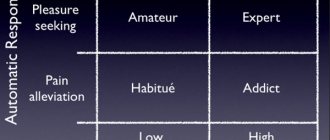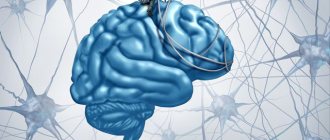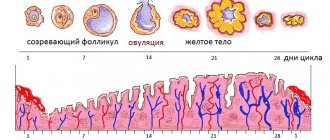What is senestopathy
Senestopathies
- conditions in which patients describe painful, unpleasant, sometimes painful sensations that occur in various parts of the body, localized both on the surface of the body and on the internal organs. In this case, no pathology is detected at the site of this sensation (there is no inflammation, no damage, no displacement).
Senestopathies are consequences of disorders in the functioning of the brain and psyche. They may have a permanent localization, but are sometimes accompanied by sensations of “migration of symptoms,” moving from the surfaces of internal organs to the surface of the skin and back.
Senestopathic sensations may be pretentious and unnatural. Almost always accompanied by increased attention to this symptom, they can reach such severity that they become difficult to tolerate.
Many patients even describe the suffering caused by senestopathy as worse than pain.
Symptoms of senestopathy
The symptoms of Senesthopathy are characterized by a large number of different painful sensations that are not localized. When trying to describe feelings, he cannot clearly define where it hurts and in what intensity. Often, experts observe a strong emotional coloring: painful and painful sensations. It is important to note that some patients report emotional distress rather than physical distress. They constantly concentrate on possible painful sensations, unable to be distracted by another subject.
Another difference is the unusual projection. The patient often indicates pain in a place where, according to medical indicators, there should not be pain. Most often, unpleasant sensations manifest themselves in the form of headaches, less often in the chest, heart and limbs. Senesthopathy can occur periodically or on an ongoing basis, sometimes manifesting as attacks.
Symptoms of senesopathy
Senestopathies may resemble burning, compression, “painful beating or pulsation,” numbness, twisting, “sprouting,” piercing, or “freezing.”
One patient described a feeling of pressure on the inside of the nose, as if the skin was peeling off and the nose itself was splitting in two. These conditions arose as long-term consequences of psychoactive substance use. Moreover, several months passed between the actual use of the substance and the onset of senestopathic sensations.
Senestopathies are always accompanied by changes in the functioning of the central nervous system and mental disorders. Senestopathies have a close relationship with hypochondriacal experiences (obsession with one’s health), with depressive symptoms, anxiety, and sleep disorders.
Types of senestopathy
- thermal sensations in the form of burning, cold or heat;
- bodily sensations, for example, a feeling of turning over, shifting, twisting, sticking together;
- movement of fluid in the body in the form of transfusion, clogging, pulsation;
- painful sensations - burning pain, tingling, drilling, squeezing, tearing;
- feeling of muscle tension, presence of a foreign body.
Types of symptoms
- Hallucinatory - sensations similar to hallucinations. Geometric, for example, in the stomach there is a ball from which pain comes with a projection onto the whole body. Tactile, the feeling of a blow to the body, someone pulling the hair, the head shaking on its own. Transformational, sensation that the brain is leaking or evaporating. May be accompanied by gustatory, visual, olfactory, and acoustic sensations. The difference from hallucinations is expressed in the relative nature of the descriptions (as, as if).
- Interpretative - rich in various interpretations, usually unusual. For example, complaints of a “freezing” brain “freezing”, “pain in the surface of the rib” or “itching” of the liver. Organotopic, associated and delusional senestopathies can be distinguished. Characterized by a false version, for example, “blood” does not enter the liver.”
- Elementary - destructive sensations that do not have a clear localization. For example, people suffering from manic-depressive disorder describe it as “constant internal stress,” which is difficult to describe.
- Simple - sensory. Pain, burning, etc. are projected onto the area corresponding to the patient’s sensitive area. Discomfort appears in any part of the body. Clear localization is not typical.
- Psychosensory senestopathy - sensations of changes in volume, size and orientation. For example, a feeling of a knotted stomach, fullness in the chest, pressure or squeezing in the head, twisting of joints, changes in the position or size of any part of the body.
Causes of senestopathies
The main disorders that trigger senestopathic sensations occur in the brain: the exchange of neurotransmitters in the brain changes, the transmission of nerve impulses between neurons is disrupted, and the midline structures of the brain are activated and overexcited.
Diseases that can occur with senestopathies (most common):
- Depression,
- Anxiety disorders (including panic attacks),
- Psychoses,
- Schizotypal disorder
- Schizophrenia,
- Consequences of organic damage to the central nervous system,
- Liver diseases in combination with encephalopathy,
- Alcoholism, drug addiction, substance abuse,
- Poisoning.
In addition to diseases, senestopathies can also occur under stress, overwork and exhaustion.
As one of the variants of “non-painful senestopathy”, one can describe the feeling of a wave of heat throughout the body during severe fear, which can be observed in many people and passes without a trace in a few seconds.
Causes of senestopathy
Typically, senestopathies arise against the background of mental disorders.
Senesthopathy, what is it? Senestopathies are various unpleasant, depressing sensations both inside the body and on its surface. They may resemble twisting, squeezing, pulling, bursting, burning, pulsating, etc. The distinctive features of the described disorder are considered to be a lack of objectivity, a feeling of unnaturalness and the absence of a truly existing pathogenic process that explains the sensations experienced by the individual.
Senestopathies are sensations of a psychological nature that the patient projects into the image of his body. Today, the described disease has not been sufficiently studied, as a result of which it is impossible to obtain an unambiguous answer about its etiology, since it is believed that the origin of this pathology is due solely to psychological reasons. In addition, practice shows that more often this disorder occurs as a companion to various mental problems. Often observed in oneiroid, neuroses of various etiologies, in the depressive phase of manic-depressive syndrome, psychoorganic syndrome, affective-delusional states, paranoia, paraphrenia, senestopathosis and a number of other anomalies of mental activity.
Despite the fact that numerous studies aimed at understanding the mechanism of origin of the described disorder have not yet discovered clear causes of the disorder, they have made it possible to identify some patterns. For example, there are a number of diseases that cause the appearance of this disease, among which are:
— organic pathology of the nervous system;
— toxic lesions, including alcohol or toxic poisoning, drug addiction;
- schizophrenia;
- senestopathies with neurosis.
The described unpleasant sensations occur in various areas of the body. In addition, in terms of localization, senestopathy does not correspond to specific anatomical structures and is usually the basis for hypochondriacal or delusional ideas. Nocturnal senestopathy is also common.
Also, the described violation can be complex (qualitative) and simple (quantitative). The former include significant changes in body structure, metamorphopsia, and in some cases illusions and hallucinations, while the latter include hyperesthesia.
This disease is quite rarely characterized by an independent course, not complicated by nervous disorders and mental disorders. Sometimes there are organic or functional lesions that help substantiate the complaints made by patients. They can help to detect an inflammatory process, vascular spasm or pain.
It should be noted that true senestopaths do not have mental reactions, this especially applies to sensitive reactions. The patient complains about painful sensations, but they do not completely absorb him and are not a fixation. An individual suffering from this disorder is an organically ill subject who does not have a clear justification for his own pain. In some cases, senestopathy is found beyond the boundaries of its nosological identification.
Treatment of senestopathies
Since there is no such disease - senestopathy, it is just a symptom and one of the signs of the disease, treatment begins with identifying the cause, establishing the underlying disease.
The examination and diagnosis begins with an examination by a psychotherapist, psychiatrist or neurologist. An experienced doctor can make the correct conclusion and prescribe treatment during the consultation.
Sometimes additional examinations are required to help clarify the doctor’s assumptions and exclude concomitant diseases that occur with similar symptoms. The most commonly used tests for senestopathy are:
- Blood and urine tests (general, biochemical, hormones and markers);
- Electroencephalography, tomography (magnetic resonance or computer), ultrasound examination of blood flow;
- Electromyography;
- Study of all types of sensitivity;
- Pathopsychological and neuropsychological research;
- Consultations of related specialists: therapist, surgeon, endocrinologist, etc.
Treatment of senestopathies is carried out at home (for recently emerging and unexpressed symptoms) or in a specialized clinic (for intractable painful sensations, long-term senestopathies that are difficult to treat).
Treatment methods used for senestopathy:
- Drug treatment: neurometabolic, restorative therapy, neuroleptics, antidepressants, mood stabilizers, tranquilizers.
- Physiotherapy: electroanalgesia, electro-sleep, electrophoresis;
- Reflexology;
- Massage, manual therapy;
- Mud therapy and water treatments;
- Xenon therapy;
- Light therapy and color therapy;
- Diet therapy;
- Psychotherapy: cognitive, psychodynamic, existential, individual and group.
In the vast majority of cases, senestopathy is a reversible phenomenon.
How to recognize senestopathy?
Senesthopathy is recognized by the discrepancy between sensations and real problems in the body. There are different sensations:
- Thermal: burning, cold, heat.
- Movement of fluids: pulsation, clogging, transfusion.
- Feeling of tension.
- Circumstriptive: drilling, burning pain.
Depending on the sensations that a person experiences, hallucinatory, simple, elementary, psychosensory, and interpretative senesthopathy are distinguished.
Each patient describes in his own way the sensations that bother him. At the same time, they are complemented by a feeling of internal organs turning over and a feeling of sticking together in the area of pain.
According to the descriptions of the complainants themselves, the pain is localized mainly in the head, chest area and, less often, in the limbs.
Often patients invent symptoms that they do not actually feel, and even invent illnesses. However, they cannot describe their feelings; they take a long time to find words. This pathology resembles hallucinations, delusions, persistence, affect, and depersonalization.
At the beginning of the development of the disease, a person describes his sensations, which are static and permanent. However, as senesthopathy develops, the symptoms become more and more vivid, intense, and the pain becomes migrating and inconsistent. Patients constantly concentrate their attention on the sensations that excite them, so they describe them vividly and with all the inspiration.
go to top
Treatment of senestopathy at the ROSA clinic
- Our clinic offers quick and effective assistance for these conditions.
- Treatment is carried out by doctors with extensive experience in helping with all types of senestopathies.
- We work around the clock.
- Reception is carried out in comfortable conditions upon your first request. Located next to the metro, there is parking.
- A specialist can come to your home.
- We use effective and safe treatment methods.
- Help with previous ineffective treatment.
If you have any additional questions about senestopathy, we will be happy to answer you by phone. Call or send a request.
Treatment of senestopathy (psychiatry)
First of all, a specialist must differentiate the patient’s condition and exclude possible physiological diseases of the internal organs. In addition to physical examination, psychotherapists and psychologists work with the patient to make a diagnosis.
If the disease is accompanied by psychosis, then antipsychotics can be used in treatment. With the development of neurosis - antidepressants and tranquilizers.
When senestopathy becomes chronic, this means that qualitative changes have occurred in the brain, which may be irreversible. If such a pathology occurs, then psychotropic drugs will no longer be able to cope with the disease. As an additional therapy, many specialists use hypnosis to find out the causes of the syndrome and reduce the manifestation of side symptoms.
The treatment plan is created exclusively on an individual basis after all examinations have been completed. Therefore, there is no clear picture of treatment in general terms and specialists primarily rely on the collected anamnesis.
Simple senestopathies
Their characteristic features are:
- a distinct and usually monomorphic perceptual modality. These are pain, thermal sensations, tactile sensations, sensations of pressure, vibration;
- localization limited to certain topographic zones;
- projection corresponding to the normal modality of one or another type of sensitivity;
- significant similarity with general somatic painful sensations;
- the presence of subdepressive mood with depression and anxious-phobic inclusions. This is probably what accounts for the heightened emotional reaction of patients to the fact of senesthopathy; however, no inadequate interpretations are identified. Simple senestopathies in this sense can probably be designated as depressive.
Some authors present simple senestopathies differently. Thus, M.I. Rybalsky (1983) includes “real sensations, usually monomorphic, caused by organic changes, somatic suffering, but not quite familiar, causing an increased reaction of the patient in the form of anxiety, fear and not accompanied by a disorder of thinking.” The second group of senestopathies according to M.I. Rybalsky is “illusory senestopathies”, i.e. “perverted real sensations... with significant involvement of the thought process up to the formation of obsessive and overvalued ideas.”
In these definitions, the author combines two things: real sensations of somatic suffering and disturbances in the perception of these sensations. He calls real or hallucinatory senestopathies fanciful, usually polymorphic, sensations without an organic basis or external causes, accompanied by impaired thinking. M.I. Rybalsky points out the important fact that patients with simple and especially illusory senestopathies may incorrectly perceive real sensations, including those arising from somatic illness. But this is a separate question, not entirely clear, by the way. The author, we note, does not directly state anywhere that erroneously perceived normal sensations can also be senestopathies.
The essence of the problem of senestopathy consists, we believe, in finding the correct answer to the following three questions:
- Are senestopathies a normal perception of sensations that are normal or abnormal in one way or another;
- Do they represent a painful perception of real, actual sensations, including those characteristic of somatic pathology;
- Are they imaginary painful sensations?
If it turns out, let us assume, that the correct answer to the third question is affirmative, then in fact this means that genuine senestopathies are a hallucination of sensation, i.e., exclusively a symptom of the pathology of self-perception. If they represent a distorted perception of actual sensations, then they should be considered as a receptive illusion, the main thing in which is again the pathology of self-perception. In the same case, if the perception of sensations in itself is not impaired, then it should then be recognized that senestopathies are only abnormal sensations and nothing else; they are, therefore, a consequence of the pathology of the sensory organ itself.
The last answer would mean, perhaps, only one thing, namely: senestopathy is a symptom of organic, local damage to receptors, sensory conductors, the thalamus or cortical sensory zones. Neurological pathology, as is known, has no such precedents. The second answer could mean that patients with senestopathies are characterized by both impaired awareness of real sensations and a pathology of the formation of sensations. There is currently no evidence that this form of pathology exists. In other words, there is no evidence yet that indicates that patients with senestopathies experience loss of sensitivity, and the vacated space is taken by senestopathies. One thing remains: senestopathy is an imaginary feeling of somatic distress.
In other words, such patients simultaneously have two streams of sensations that do not merge anywhere: one is ordinary, normal, including those caused by somatic pathology, the other is pathological, imaginary. This is the same situation as with hallucinations, when patients correctly perceive real things and at the same time produce imaginary visual images. But the main thing is that regardless of whether we are dealing with receptive illusions or hallucinations, the essence of the disorder still comes down to one thing - the pathology of self-perception.
Let us give a description of some types of simple senestopathies, suggesting that their number can be significantly increased.
Algic senestopathies, or senestoalgia , are imaginary pain sensations. Previously, it was mentioned that there are various phenomena of hyperalgesia that have little in common with senestopathies. The difference between senestoalgia and hyperalgesia and real pain is reflected in the following illustrations: “The heart hurts, aches, presses, expands, it seems like it’s about to burst... Behind the sternum, somewhere in the depths it hurts, the pain is tearing, restless, groaning, impossible. Like a sledgehammer, and then the whole body groans... Incredible pain in the head... Wild pains inside the head, I think I'm going crazy... The pain in the heart is cracking, breaking... The pain in the head is like a stake... Pain in the chest, as if something had pierced it... The heart hurts, squeezes, flattens... Wandering pains in the chest... The whole body hurts, there is no living space, then in one place it hurts, presses, squeezes, then in another, the whole body goes through... The head hurts in different parts, it moves here and there here... It presses, it hurts in the side, from there it’s as if it’s squeezing something out... For three years it’s been hurting in the back, it’s bruising, it’s gnawing near the vertebrae.”
The fact that it is senestoalgia is convinced by such signs. Senestoalgia, firstly, is distinguished by an incredible variety of shades of pain. These are pains that are drilling, breaking, gnawing, moaning, pressing, cutting, shooting, itching, twisting, twisting, cracking, breaking, bursting, tearing, crazy, wild, breaking and many others. etc. At the same time, such polymorphic pain often occurs in the same patient. Secondly, the pain can be persistent, persistent, localized in one place for many years, or it seems to move, “wander,” “walk,” “flow” from place to place. Thirdly, pain often has a tinge of synesthesia - “moaning pain”, “crackling pain”, etc. Fourthly, senestoalgia clearly shows a tendency to develop into more complex senestopathies - the heart “flattens”, the pain “bursts”, which something is “squeezed out”, etc. Quite often, fifthly, along with senestoalgia, very strange, fanciful senestopathies are detected.
And, finally, a tendency towards unusual localization of senestoalgia is often revealed - pain “inside the head, near the spine”, etc. A final judgment about the fact of senestoalgia can be made only after a thorough somatic examination. Usually the latter does not reveal any pathology or, which happens especially often, the identified pathology and senestoalgia do not have a causal relationship with each other, although, and this should be noted, there are often cases when the localization of senestopathies is tied to foci of any physical damage in past. Often there are considerable difficulties in distinguishing between the complaints of patients with senestoalgia and the physical complaints of hysterical patients. The main distinguishing feature, perhaps, is that in the complaints of hysterics there is too much vagueness that cannot be analyzed, such as, in particular, what has just been given. Hysterics, in addition, complain “easier”; it is not clear from them that they suffer much from pain.
Thermal senestopathies are imaginary sensations of burning and, less often, cold: “Burning of the soles... Like burning between the shoulder blades... The whole body is burning, as if scalded with boiling water... The whole body is burning with fire, and there is cold inside... The cheek seems to be frozen... The lower back burns as if it had been whipped with nettles... Your forehead is burning like it’s on fire... Your heels are freezing.” Descriptions of patients with senestotermia differ from those with dystermesthesia in that senestopathies occur autochthonously, outside and independently of thermal stimulation.
There are other disorders that should be distinguished from thermal senestopathies. This is, for example, the syndrome of paroxysmal hypothermia described in neurotics (Polzien, 1962). The disorder manifests itself in episodic conditions with a decrease in body temperature by 0.7–1.3°C. Patients experience a feeling of heat. At the same time, hyperhidrosis, tachycardia, dizziness, nausea, difficulty breathing, and a feeling of fear for health occur. The painful episode ends several hours later with a feeling of coldness in the body or chills, as well as weakness.
Senestopathies in the form of paresthesias or senestoparesthesias are experienced by patients as sensations of crawling, tickling, itching, tingling, electrification, numbness: “Goosebumps in the groin, they rise from below, then spread in different directions... Itching in the legs below the knees... Tickling on the head... Hands are numb and pokes with needles... Tingling in the tongue... The skin seems to be electrified... Tingling in the legs, as if piercing right through.”
Simple senestopathies, at first mostly static, subsequently become mobile, as if migrating: “The burning sensation spreads to the sides, appears in different places... The pain is walking, floating, wandering... Walking pain in the chest. "Goosebumps rise from the sacrum to the back of the head." At the same time, a tendency towards increasingly unusual localization is revealed: “Pain in patches on the head... The skin hurts... Pain inside the head... Pain in the bones... The spine hurts... Superficial burning in the skin of the forearm... Pinching around the eyes.” In addition, there is a tendency to change the projection of sensations: “Numbness somewhere inside in the arms and legs... Tingling somewhere in the depths... The pain in the head is sharp, it pierces like an awl.”
Treatment
To date, the scientific community has not yet developed common ideas on how to treat this disease. Some experts completely deny the prospects for treating senestopathies with medications. Others claim the opposite and claim that with the right combination of drugs and their dosage, healing occurs easily and quickly. In this case, all three main types are used:
- antidepressants;
- tranquilizers;
- antipsychotics.
Worth seeing: Glycine for neurosis
Neuroleptics (antipsychotics) are usually represented by Haloperidol, minor tranquilizers by Elenium, and antidepressants by Amitriptyline. All this is prescribed in the most modest doses. Some experts believe that when senestopathy becomes chronic, irreversible damage occurs in the brain, but this assumption should not be completely trusted, since extensive research has not been conducted to confirm such statements.
Senesthopathy is often treated with antidepressants prescribed by a doctor
There is no single approach to what psychotherapy should be. It is clear that treatment will only become effective when the patient himself understands the inconsistency of his physical sensations, but there is no clear method of how this could be achieved.
The difficulty is that informing the patient hardly helps. Patients very rarely make certain diagnoses for themselves, so they cannot be dissuaded from the fact that they suffer from cancer or osteochondrosis. They don’t think so, but they complain about something fantastic. It is impossible to reassure a person who feels pain or burning that he does not feel it.
It is possible that it is for this reason that medications have a certain effect. When a person understands that medications for the treatment of mental disorders help him, he ceases to correlate his sensations with the disease of some parts of the body, skin or internal organs.
Psychosensory senestopathy
Psychosensorial senestopathy is an imaginary painful sensation with clearly expressed spatial characteristics, i.e., with signs of volume, dimension, direction of movement: “The chest swells, expands, enlarges, stretches... Something comes out from the back of the head. There is pressure on the inside of the head... The head is bursting from the inside, it seems to burst... There is pain in the head, and something is turning over in the temples... It’s as if a knot is being tied in the stomach... The veins are being pulled, twisted... Something is twisting, folding, compressing, gathering into folds inside ... Presses on the forehead from the inside out... It’s like something is spinning and spinning in the head... Presses on the head from the outside towards the center... The pain is oblique, goes from the left and up.” Along with senestopathies, patients often exhibit episodic symptoms of autometamorphopsia: “Pain in the joints, they are twisted in the other direction... The head is compressed, and there is a feeling that it is decreasing in size... It is bursting in the chest, and the chest is rising... Stretching pain in the legs, it’s like the legs stretched out... The skin of the face is pulled, the nose seems to have become sharper.” Violations of the body diagram that are not associated with senestopathies may also be identified. Symptoms of allometamorphopsia are detected much less frequently.
Hermeneutic senestopathies are imaginary painful sensations, accompanied by different interpretations regarding their topic and causes of development. Often these interpretations come to the fore, so that the actual sensations remain in the descriptions of patients, as if in the shadows. The patients' interpretations are very reminiscent of delusional ideas of hypochondriacal content and ideas of dysmorphomania. Depending on the emphasis in this interpretation, the following senestopathies can be identified.
Organotopic senestopathies are pathological sensations that are localized by patients in some organs: “Pain inside the eye sockets... The eardrum vibrates... The vessel in the head itches... Under the skull the vessels pulsate... The vessel under the skin ruptures... By the evening the eyelids begin to hurt... The inner plate of the frontal bone hurts ... Burning in the pericardium and at the apex of the heart... Pain in the three thoracic vertebrae... Pain along the ureter... The apex of the left lung is freezing... Pain at the base of the skull between the hemispheres... Pain in the walls of the stomach... The surface of the cerebral hemispheres tingles and goes numb... The cerebellum burns.”
Associated senestopathies and pathological sensations that patients combine into a semblance of a certain structure: “Pain from the arm goes along the line upward, hits the back of the head, then compresses the heart, and then diverges in the stomach in different directions... Pain from the sternum moves to the tonsils, from there it goes to the heart, and from the heart rises to the head... The pain from the legs stretches up along two lines along the back, moves to the neck, where it ends in two vague points... Numbness of the lower leg turns into a sensation of pain at a point on the thigh, then the inguinal arteries begin to ache, and then the pain becomes subconscious... The central nervous system sends an impulse to the stomach, the stomach contracts, the shocks are sent to the groin, from the groin through a vein they pass to the leg, and then to the big toe of the left foot, from where they return back to the groin. It turns out to be a vicious circle that needs to be broken, and then I will be healthy. To break the connection between the thumb and the central vein through which the finger influences the groin, the thumb must be removed. I have already addressed this request to the surgeon more than once.”
Delusional senestopathies are pathological sensations with imaginary causal connections established by patients: “Blood does not flow into the rectum... Vessels burst... Vessels are thrombosed and the brain does not receive nutrition... The brain lacks oxygen due to lung disease... The veins in the head are inflated, the outflow of blood is disrupted... The blood flow is slowed down, so it’s cold, chilly and the metabolism is disrupted... Dull pain in the heart due to relaxation of the heart muscle... Pain in the cerebral cortex of the inflammatory type.” These patient formulations most likely arise from misunderstood explanations from doctors, reading medical literature, and sometimes they are borrowed from other patients, which the patients subsequently forget about and pass off as their own.
Hallucinatory senestopathies are characterized by the presence of distinct discriminatory elements in the sensations of interoreception, which gives senestopathies some similarity to various deceptions of perception.
Geometric senestopathies are described by patients as having a certain shape, flat or three-dimensional: “Burning on the back in the form of a triangle... Pain in the form of a flat circle... Headaches like a grid - it hurts along the perimeter of the cells, but there is no pain in the middle... Burning in the side like an elongated oval... Pain at a point under the skin of the back of the head... Pain from the point radiates in different directions... Pain from the fingers goes up to the shoulder along two parallel lines... Stripes of cold framed by warmth... Burning in the form of stars... Headache in the form of a triangle convex upward... Pain in the center of the head in the form of a luminous point... The skull hurts along the line under the ears - even chop it off in this place... The pain flashes in zigzags like lightning... A circle the size of a two-kopeck coin freezes... The points under the nails of the index fingers hurt... Ball-shaped pain... The pain rises in bubbles from the bottom up "
Senestopathies with the character of tactile hallucinations: “It’s like there’s a hat on the head... The head hurts, it’s like being squeezed by a fireman’s helmet... The skin burns as if mustard plaster was stuck or a hot iron was applied... It hit the head as if with a stick... The head is freezing, as if a cold wind is blowing it... It seems crumbs stuck to the throat... It feels like someone is pulling your hair... It’s like a cigarette is stuck to your lip... It’s like water is running down on your skin... It’s like droplets of sweat are appearing all over your body... It’s like someone is tickling you.”
Often, imaginary tactile and other external sensations are projected onto the area of interoreception: “There is a tickling in the head, as with a runny nose or allergies... Numbness in the head... Tickling in the chest... Itching, itching in the head... It’s like someone is fingering the intestines with hairy hands... Burning inside the head... In the stomach as if hot blood is pouring... Something is crawling in my head... The pain in the heart is like from a dagger, the end of which sticks out under the shoulder blade, and you just want to pull it out... It’s like a hard lump in the chest... The head is filling with something... Pain from the heart floats up in balls... Pain in the spine, as if it had been pierced by a tube with a diameter of 5–6 mm.” Senestopathies of this type are very reminiscent of visceral hallucinations.
Senestopathies with the character of hallucinations of transformation: “The brain is like a jelly-like mass... The brain seems to be liquid and gurgles... The brain is compressed into a lump... The brain is moving... The brain seems hot and small... The heart seems to be divided into parts... The muscles seem to be stratified... The heart seems to have come off and fallen down... The brain how it separated from the skull and dangles in it.”
Senestopathies with the nature of kinesthetic hallucinations: “The legs seem to be pulled towards the body... The arms, legs, mouth are brought together, the head is thrown back upward... The lips are pulled inwards... The head seems to swing back and forth... It feels like the eyes are starting to squint to the side... There is such tension in the hands, It’s like I’m holding a heavy load.”
Sometimes hallucinatory senestopathies are complemented by acoustic, gustatory, olfactory or visual elementary hallucinations of the imagination: “The brain is clearly separated from the membranes - you can hear them coming apart... There’s something squelching in my head, I hear it... Pain stretches along the threads and you can hear them rattling... Something sickly sweet is spinning in my head... Everything inside is burning, burning, I feel like it smells burnt... It hit my head, the pain flew from left to right and sparkled, like during a thunderstorm.” At the same time, most patients exhibit fragmentary deceptions of perception that are not associated with senestopathies.











